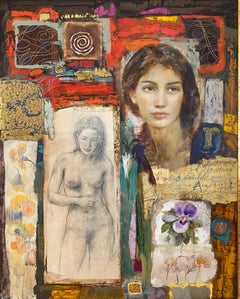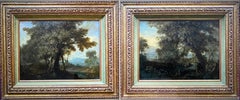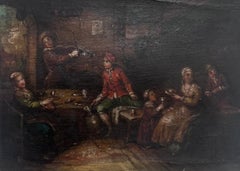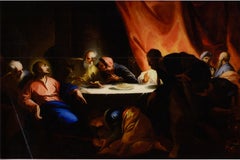Old Masters Figurative Paintings
Encompassing centuries of change in Europe between 1300 and 1800, from booms of prosperity to bloody revolutions, Old Masters describes a wide range of artists. The informal term was derived from the title of an artist who trained in a guild long enough to become a master, such as Leonardo da Vinci, who studied in a Florence painters’ guild. However, Old Masters paintings, prints and other art is now used to refer to work made by any artist with a high level of skill in painting, drawing, sculpture or printmaking who worked during this era.
The 15th century’s expansive trade and commerce spread culture across borders. A vibrant period of art emerged, bolstered by studies of anatomy and nature that influenced a new visual realism. From Raphael and Michelangelo in the Renaissance to Rembrandt van Rijn and Johannes Vermeer in the Dutch Golden Age, artists expressed emotion, naturalism, color and light in new ways. El Greco and Paolo Veronese were leaders in the dramatic style of Mannerism, while Caravaggio and Peter Paul Rubens demonstrated the movement and meticulous detail of Baroque art.
Historically, most attention was concentrated on male artists, but recent research and exhibitions have elevated the impactful work of women such as Rachel Ruysch and Artemisia Gentileschi. In late-18th-century France, female artists like Adélaïde Labille-Guiard and Élisabeth Vigée Le Brun were prominent names. Nevertheless, access to the academies and guilds was highly restricted for women, and even those able to establish practices were expected to adhere to portraits and still lifes rather than the grand history paintings being created by men.
Find a collection of Old Masters prints, paintings, drawings and watercolors and other art on 1stDibs.
17th Century Old Masters Figurative Paintings
Oak, Oil, Wood Panel
1990s Old Masters Figurative Paintings
Wood Panel, Mixed Media
18th Century Old Masters Figurative Paintings
Copper
18th Century Old Masters Figurative Paintings
Oil, Canvas
16th Century Old Masters Figurative Paintings
Canvas, Oil
17th Century Old Masters Figurative Paintings
Canvas, Oil
Early 20th Century Old Masters Figurative Paintings
Oil
17th Century Old Masters Figurative Paintings
Oil
Late 17th Century Old Masters Figurative Paintings
Canvas, Oil
Mid-20th Century Old Masters Figurative Paintings
Oil
Mid-18th Century Old Masters Figurative Paintings
Tempera
Late 19th Century Old Masters Figurative Paintings
Canvas
20th Century Old Masters Figurative Paintings
Oil
Late 17th Century Old Masters Figurative Paintings
Canvas, Cotton Canvas, Oil
18th Century Old Masters Figurative Paintings
Copper
17th Century Old Masters Figurative Paintings
Oil
16th Century Old Masters Figurative Paintings
Oil, Panel
Late 18th Century Old Masters Figurative Paintings
Canvas, Glass, Wood, Paper, Pastel
21st Century and Contemporary Old Masters Figurative Paintings
Canvas, Oil
Early 17th Century Old Masters Figurative Paintings
Canvas, Oil
17th Century Old Masters Figurative Paintings
Canvas, Oil
17th Century Old Masters Figurative Paintings
Canvas, Oil
17th Century Old Masters Figurative Paintings
Oil
16th Century Old Masters Figurative Paintings
Oil, Wood Panel
Mid-18th Century Old Masters Figurative Paintings
Oil, Canvas
Early 19th Century Old Masters Figurative Paintings
Canvas, Oil
1730s Old Masters Figurative Paintings
Canvas, Oil
17th Century Old Masters Figurative Paintings
Canvas, Oil
17th Century Old Masters Figurative Paintings
Canvas, Oil
17th Century Old Masters Figurative Paintings
Canvas, Oil
Early 17th Century Old Masters Figurative Paintings
Copper
17th Century Old Masters Figurative Paintings
Canvas, Oil
19th Century Old Masters Figurative Paintings
Canvas, Oil
17th Century Old Masters Figurative Paintings
Canvas, Oil
17th Century Old Masters Figurative Paintings
Oil
17th Century Old Masters Figurative Paintings
Canvas, Oil
Early 19th Century Old Masters Figurative Paintings
Oil
16th Century Old Masters Figurative Paintings
Marble
18th Century Old Masters Figurative Paintings
Ink, Watercolor, Archival Paper
17th Century Old Masters Figurative Paintings
Oil
17th Century Old Masters Figurative Paintings
Canvas, Oil
Mid-19th Century Old Masters Figurative Paintings
Oil
Early 17th Century Old Masters Figurative Paintings
Canvas, Oil
Early 18th Century Old Masters Figurative Paintings
Canvas, Oil
Early 17th Century Old Masters Figurative Paintings
Oil, Board
18th Century Old Masters Figurative Paintings
Canvas, Oil
Early 18th Century Old Masters Figurative Paintings
Canvas, Oil
Late 19th Century Old Masters Figurative Paintings
Canvas, Oil
18th Century Old Masters Figurative Paintings
Oil
Early 17th Century Old Masters Figurative Paintings
Canvas, Oil
17th Century Old Masters Figurative Paintings
Wood, Oil
Early 20th Century Old Masters Figurative Paintings
Oil
17th Century Old Masters Figurative Paintings
Canvas, Oil
17th Century Old Masters Figurative Paintings
Canvas, Oil
17th Century Old Masters Figurative Paintings
Canvas, Oil
17th Century Old Masters Figurative Paintings
Oil, Wood Panel
17th Century Old Masters Figurative Paintings
Canvas, Oil
19th Century Old Masters Figurative Paintings
Pencil
Late 17th Century Old Masters Figurative Paintings
Canvas, Cotton Canvas, Oil
Early 17th Century Old Masters Figurative Paintings
Canvas, Oil





